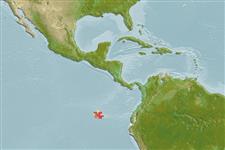Environment: milieu / climate zone / depth range / distribution range
البيئة
بحري القاع; نطاق العمق 2 - 9 m (Ref. 28023). Tropical
Southeast Pacific: Endemic to the Galapagos Islands.
Length at first maturity / الحجم / وزن / العمر
Maturity: Lm 3.3, range 3 - 3.6 cm
Max length : 5.0 cm SL ذكر/ مختلط الجنس; (Ref. 28023)
Known from tide pools and shallow coastal regions. Inhabits black volcanic sand and coarse, white coral sand, where it often occurs together with (Ref. 28023). Platygillellus rubellulus (Ref. 28023).
Life cycle and mating behavior
النضج | التكاثر | وضع البيض | بيض | الخصوبة | Larvae
Grove, J.S. and R.J. Lavenberg, 1997. The fishes of the Galápagos Islands. Stanford University Press, Stanford, 863 p. (Ref. 28023)
IUCN Red List Status (Ref. 130435: Version 2024-1)
استخدامات بشرية
أدوات
تقارير خاصة
Download XML
مصادر علي الأنترنت
Estimates based on models
Preferred temperature (Ref.
123201): 23.5 - 24.6, mean 23.8 °C (based on 14 cells).
Phylogenetic diversity index (Ref.
82804): PD
50 = 0.5000 [Uniqueness, from 0.5 = low to 2.0 = high].
Bayesian length-weight: a=0.00389 (0.00180 - 0.00842), b=3.12 (2.94 - 3.30), in cm total length, based on all LWR estimates for this body shape (Ref.
93245).
مستوى غذائي (Ref.
69278): 4.0 ±0.6 se; based on size and trophs of closest relatives
Fishing Vulnerability (Ref.
59153): Low vulnerability (10 of 100).
